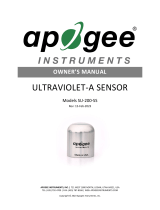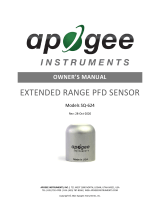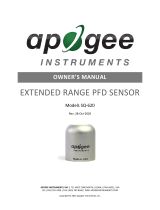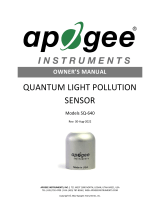Authorization (RMA) number from our technical support department by submitting an online RMA form at
www.apogeeinstruments.com/tech-support-recalibration-repairs/. We will use your RMA number for tracking of the
2. For warranty evaluations, send all RMA sensors and meters back in the following condition: Clean the sensor’s exterior
and cord. Do not modify the sensors or wires, including splicing, cutting wire leads, etc. If a connector has been attached
to the cable end, please include the mating connector – otherwise the sensor connector will be removed in order to
complete the repair/recalibration. Note: When sending back sensors for routine calibration that have Apogee’s standard
stainless-steel connectors, you only need to send the sensor with the 30 cm section of cable and one-half of the
connector. We have mating connectors at our factory that can be used for calibrating the sensor.
3. Please write the RMA number on the outside of the shipping container.
4. Return the item with freight pre-paid and fully insured to our factory address shown below. We are not responsible for
any costs associated with the transportation of products across international borders.
Apogee Instruments, Inc.
721 West 1800 North Logan, UT
84321, USA
5. Upon receipt, Apogee Instruments will determine the cause of failure. If the product is found to be defective in terms
of operation to the published specifications due to a failure of product materials or craftsmanship, Apogee Instruments
will repair or replace the items free of charge. If it is determined that your product is not covered under warranty, you
will be informed and given an estimated repair/replacement cost.
PRODUCTS BEYOND THE WARRANTY PERIOD
For issues with sensor
s beyond the warranty period, please contact Apogee at
[email protected] to
discuss repair or replacement options.
OTHER TERMS
The available remedy of defects under this warranty is for the repair or replacement of the original product, and Apogee
Instruments is not responsible for any direct, indirect, incidental, or consequential damages, including but not limited to
loss of income, loss of revenue, loss of profit, loss of data, loss of wages, loss of time, loss of sales, accruement of debts
or expenses, injury to personal property, or injury to any person or any other type of damage or loss.
This limited warranty and any disputes arising out of or in connection with this limited warranty ("Disputes") shall be
governed by the laws of the State of Utah, USA, excluding conflicts of law principles and excluding the Convention for the
International Sale of Goods. The courts located in the State of Utah, USA, shall have exclusive jurisdiction over any
Disputes.
This limited warranty gives you specific legal rights, and you may also have other rights, which vary from state to state
and jurisdiction to jurisdiction, and which shall not be affected by this limited warranty. This warranty extends only to
you and cannot by transferred or assigned. If any provision of this limited warranty is unlawful, void or unenforceable,
that provision shall be deemed severable and shall not affect any remaining provisions. In case of any inconsistency
between the English and other versions of this limited warranty, the English version shall prevail.
This warranty cannot be changed, assumed, or amended by any other person or agreement


























